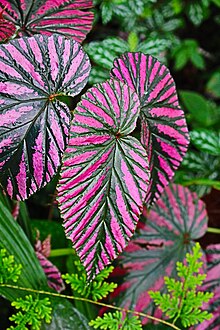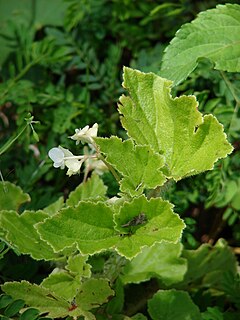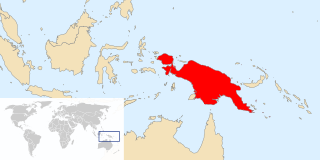
Begonia "Angel Wing" is a hybrid Begonia which resulted from a cross between Begonia aconitifolia and B. coccinea. The hybridization was made by California plant breeder Eva Kenworthy Gray in 1926.

Begonia grandis, the hardy begonia, is a plant in the begonia family, Begoniaceae. It is a herbaceous plant with alternate, simple leaves on arching stems. The flowers are pink or white, borne in dichotomously branching cymes from late summer through fall in USDA U.S. Hardiness Zone 7. As the common name "hardy begonia" implies, it is winter hardy in some temperate regions.

Duponchelia fovealis is a species of moth of the family Crambidae described by Philipp Christoph Zeller in 1847. It is endemic to the area surrounding the Mediterranean Sea, and the Canary Islands, but has extended its range to other parts of Africa, Europe, the Middle East and North America.
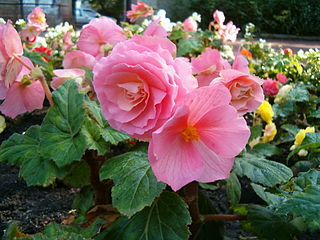
Tuberous begonias are a group of Begonia cultivars, regarded as some of the most spectacular of the genus.
Begonia boliviensis is a plant in the begonia family, Begoniaceae, which was introduced to Europe in 1864 by Richard Pearce who discovered it in the Bolivian Andes, although the plant had previously been identified by Hugh Weddell in the same region but not introduced.
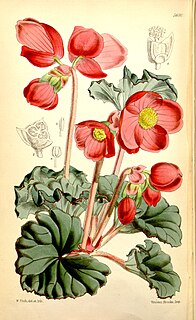
Begonia veitchii is a plant in the begonia family, Begoniaceae, which was introduced to Europe in 1866 by Richard Pearce who discovered it in the Peruvian Andes near Cusco at an elevation of from 10,000 feet (3,000 m) and 12,000 feet (3,700 m). It was named after Pearce's employers, James Veitch & Sons of Chelsea, London. It can be found today in the mountains around Machu Picchu. A later plant collector, Walter Davis, found Begonia veitchii inhabiting rocky positions by waterfalls, in company with Masdevallia veitchiana.
Richard Pearce was a British plant collector, who introduced the tuberous begonia to England, which led to the development of the hybrid begonias grown today.

Begonia sutherlandii, known as the Sutherland begonia and as iwozya in Kimalila, Tanzania, is a tuberous flowering perennial plant in the family Begoniaceae, growing to 0.5 metres (20 in) with fleshy pink stems from 10 to 80 centimetres long. Leaves are commonly dark green and veined with red and covered with short hairs on the underside. They are asymmetrical in shape and the margin is toothed. Flowers, produced in pendent panicles throughout summer, are 20–26 millimetres (0.8–1.0 in) in diameter, and are usually orange or orange–red with yellow anthers.
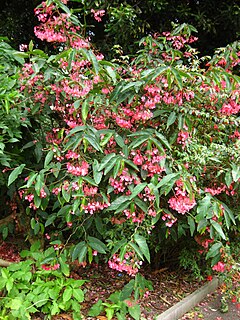
Begonia coccinea, the scarlet begonia, is a species of plant in the family Begoniaceae. It is native to the Atlantic Forest of Brazil.
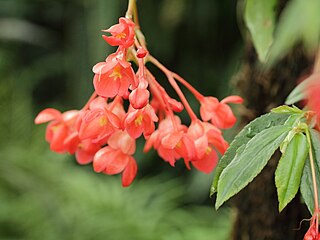
Begonia foliosa is a species of flowering plant in the family Begoniaceae, native to Colombia and Venezuela. It is a shrublike begonia growing to 1 metre (3.3 ft), bearing succulent, pendent stems 45 centimetres (18 in) long, thickly clothed with glossy oval green leaves, and producing panicles of small white flowers. The variety commonly cultivated is B. foliosa var. miniata with pink or red flowers. As it does not tolerate temperatures below 0 °C (32 °F), in temperate regions it requires winter protection.

Begonia listada is a species of flowering plant in the family Begoniaceae, native to Brazil. It is a compact shrublike evergreen begonia growing to 0.5 metres (20 in), bearing succulent green leaves with a prominent rib of lighter green, and a reddish underside. It produces small pink-tinted white flowers intermittently throughout the year. As it does not tolerate temperatures below 10 °C (50 °F), in temperate regions it must be grown under glass.
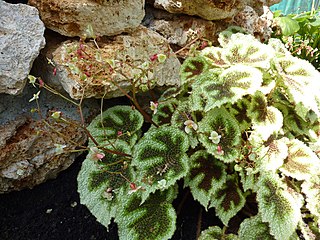
Begonia masoniana, the iron cross begonia, is a species of plant in the family Begoniaceae, native to southern China and northern Vietnam. It was originally described from cultivated plants of unknown origin and was only much later rediscovered in the wild. It is a rhizomatous perennial begonia growing to 0.5 metres (20 in), bearing large, asymmetrical, textured green leaves covered in reddish hairs, with a prominent dark brown pattern in the centre of each leaf, reminiscent of the German Iron Cross. It produces small white flowers in erect panicles, but is cultivated mainly for its foliage effect. In temperate regions it must be grown under glass, or in a completely frost-free environment. Although sometimes (incorrectly) considered a rex begonia, this species is classified in the related section Coelocentrum.
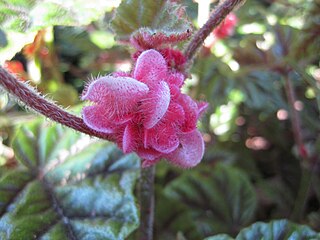
Begonia incarnata is a species of plant in the family Begoniaceae, native to Brazil. It is a shrublike evergreen perennial growing to 1 metre (39 in), bearing large, asymmetrical green leaves with a metallic sheen, and dark green veins. It produces small hairy pink flowers. As it does not tolerate temperatures below 10 °C (50 °F), in temperate regions it must be grown under glass.

Begonia baccata is a plant species of the genus Begonia in the family Begoniaceae, first described by Joseph Dalton Hooker in 1866. It is endemic to São Tomé Island, and grows up to 4 metres tall. It closest relative is Begonia crateris, also endemic to São Tomé.
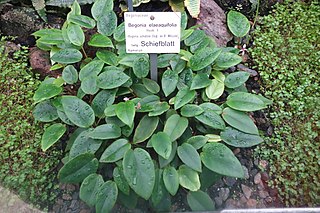
Begonia elaeagnifolia is a plant species in the family Begoniaceae, native to Africa from Cameroon to the Congo. Its small flowers are white-tipped pink.

Begonia aconitifolia is a species of plant in the family Begoniaceae, endemic to Brazil. It grows up to 1 meter in height, with panicles of pink flowers.
Begonia rubroracteolata is a species of Begonia was found in the forests of Sarawak, Borneo, where 28 other Begonia species live. The discovery was found in 2016 by S.Julia & C.Y.Ling. The small plant grows on sandstone boulders and do well in shaded areas. This herb, which is critically endangered, was found on one site of forest conversion.
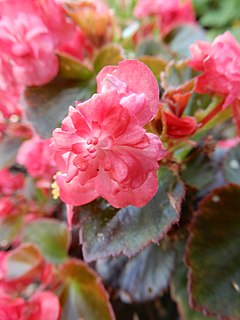
Begonia cucullata, also known as wax begonia and clubed begonia, is a species of the Begoniaceae that is native to South American countries of Argentina, Brazil, Paraguay, and Uruguay. A common garden plant and part of the section Begonia, it was described in 1805 by Carl Ludwig Willdenow (1765–1812). The specific epithet "cucullata" means "resembling a hood" or "hooded".
